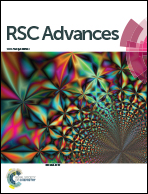Stabilizing effects of cations on lipases depend on the immobilization protocol†
Abstract
The effect of an additive on enzyme stability used to be considered an intrinsic feature of a lipase. However, in this paper we have found that the effect of additive on enzyme stability depends on the immobilization protocol. After assaying the effects of diverse chloride salts with different cations on different lipases activity, no relevant effect was detected. Free enzymes or the covalently immobilized enzymes are not stabilized by these cations for any of the studied lipases. However, Mn2+ and Ca2+ (at a concentration of 5 mM) are able to greatly stabilize the lipases from Rhizomucor miehei (RML) and Candida rugosa (CRL) when they are present during the inactivation, but only if the enzymes are immobilized on octyl-agarose (stabilization factor ranging from 20 to 50). The effect was only detected when using more than 2.5 mM of the cations, and reached the maximum value at 5 mM, suggesting a saturation mechanism of action. The stabilization seemed to be based on a specific mechanism, and required the recognition sites to be saturated by the cations. Mg2+ has no effect on enzyme stability for both enzymes, but it is able to suppress the stabilization promoted by the other two cations using CRL; while it has no effect on the cation stabilization when using RML. This is the first report of a cation induced enzyme stabilization effect that depends on the lipase immobilization protocol.


 Please wait while we load your content...
Please wait while we load your content...